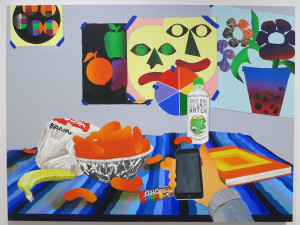In the past, front-page news has been source material for Dashiell Manley’s canvases; his recent series explores his emotional and psychological reactions to the news of the day. (At Marianne Boesky Gallery in Chelsea through Dec 17th.)
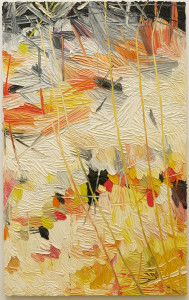
In the past, front-page news has been source material for Dashiell Manley’s canvases; his recent series explores his emotional and psychological reactions to the news of the day. (At Marianne Boesky Gallery in Chelsea through Dec 17th.)

It’s easy to recognize this scene by legendary photographer William Eggleston, without even knowing where it was shot. Typically Eggleston, its bright, saturated colors and subject matter featuring an everyday American landscape and vernacular architecture are deeply familiar. (At David Zwirner Gallery in Chelsea through Dec 17th).
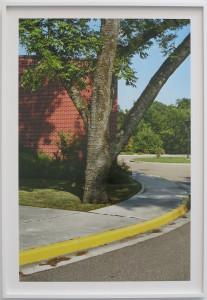
Though Michele Abeles’ photos look like appropriated commercial images, they are the artist’s own, transferred to a tablet prepared with various liquids and rephotographed. The resulting multi-layered effect blends oddness, familiarity and accident. (At 47 Canal through Dec 18th).
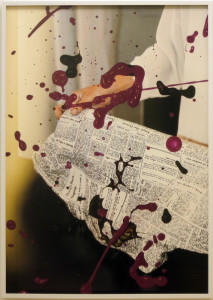
Pittsburgh-based artist Vanessa German assembles a stunningly arrayed army of folk characters for her current show at Chelsea’s Pavel Zoubok Gallery. The figure in the foreground holds a lantern aloft as if to metaphorically light the way forward; a mother with an astounding headdress of ceramic devotional sculpture holds her limp child to the right; a figure at back speaks for social justice by holding up a stop sign. (Through Nov 30th).
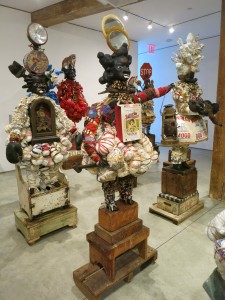
Thirty foot long sheets of paper, covered in Zipora Fried’s handmade marks in colored pencil and graphite hang like banners from the ceiling of On Stellar Rays, announcing the amount of time and effort Fried put into her project. Installed in folds, viewers don’t see the full extent of Fried’s mark-making but can still absorb the deeply calming cobalt and delft blue colors. (On the Lower East Side through Dec 4th).
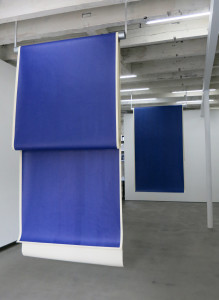
Berlin-based artist Matthias Bitzer’s paintings, mixed media works and sculptures at Marianne Boesky Gallery are uniquely difficult to categorize. Constructed from concrete, wood, glass and more (and those are just the 2-D, wall mounted works), elegantly minimalist artworks take the eye on an adventure of materials. (In Chelsea through Dec 17th).
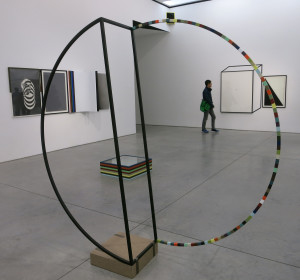
Brooklyn artist Andrew Lenaghan rewilds the High Line in this tiny painting of massive buildings, as seen from the elevated park. Dereliction and new development are Lenaghan’s themes; how they seem to merge is his intriguing angle. (At George Adams Gallery through November 30th).
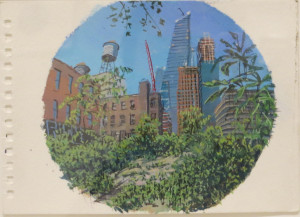
Color gels and the wisteria vine from Bryan Graf’s studio/greenhouse combine to make a ghostly image with alluring depth at Yancey Richardson Gallery. (In Chelsea through Dec 3rd).
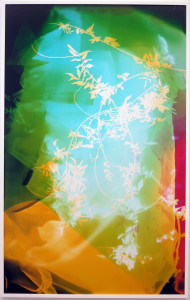
Brooklyn-based Lithuanian sculptor Aidas Bareikis continues to mine the world’s junk for his intense sculptural accumulations. Here, ‘Too Much Seaweed’ suggests a global warming meltdown or a calving of the planet. (At Canada New York on the Lower East Side through Dec 4th).
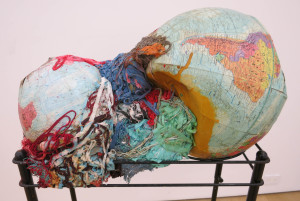
British painter David Hepher explains that like landscape painters before him (Constable, Turner, Cezanne), he paints spaces with which he’s familiar, returning again and again to explore nuances of the well-known. For Hepher, that means South London tower blocks, hulking brutalist buildings whose concrete walls have seen better days. Merging distant views and closeups of spray painted walls and graffiti, this painting both closely examines tower life and keeps it at a distance. (At Flowers Gallery in Chelsea through Dec 10th).
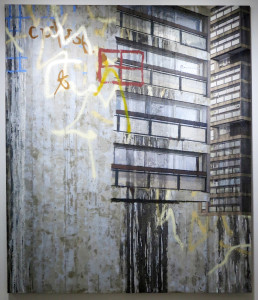
Tiny ghoulish characters – a blue faced man with huge teeth, a sinister frog in a t-shirt – populate young Swiss artist Vittorio Brodmann’s paintings of brick walls. Two sided and hung in the window to show bricks both inside and out, the paintings suggest neighborhood decline but also offer the wall as (literal) canvas. (At Gavin Brown’s Enterprise through Nov 13th).
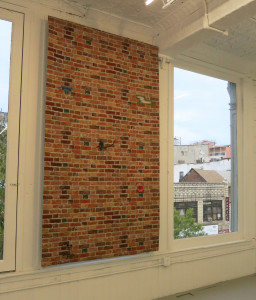
Every word in Brooklyn artist John O’Connor’s text stories packs a punch. Drawing in colored pencil using myriad fonts, he employs brand logos, emojis and pictograms to tell the tale of a young consumer whose life has taken a turn for the bizarre. (At Pierogi through Nov 13th).
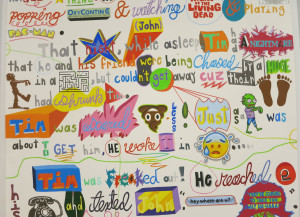
Whether they hover over desolate wastelands piled with junk or barren city streets, Masakatsu Sashie’s floating spheres add another ominous note to already bleak, futuristic landscapes. Composed of old machines or cobbled together from an assortment of panels and featuring text that appears to be ads, the orbs grimly foretell a post-human world. (At Jonathan LeVine Gallery through Nov 12th).
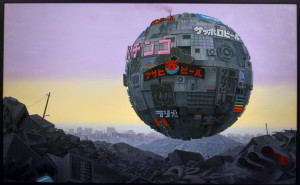
Wood makes a surprise appearance in sculptor and ceramic artist Arlene Shechet’s latest sculptures at Sikkema Jenkins & Co., challenging ceramic for primacy in pieces like ‘I Saw the 18th Century.’ Shechet is also currently showing new work at the Frick Collection inspired by 18th century porcelain, but the pieces in Chelsea bear little resemblance to the delicate results of her uptown project, instead suggesting the sturdiness of a corseted matron from a past century. (In Chelsea through Nov 12th).
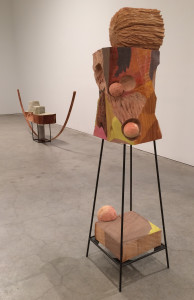
Using voter machines from the 40s, 50s and 60s, Luke DuBois presents gallery-goers with some more esoteric choices than the U.S. public faces in today’s election (us vs them, water vs fire, nature vs machine). Once visitors have locked in their votes, a unique video response interprets the data. (At Bitforms Gallery through Dec 23rd).
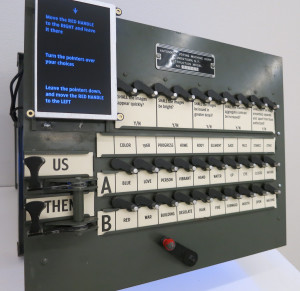
An epic battle between divine beings – scrawny-armed ‘Undom Engle’ on the left and the pink, wolf-like creature ‘Repaint’ to the right – vividly kicks off Trenton Doyle Hancock’s intense new show at James Cohan Gallery. Though it helps to know the language of Hancock’s invented mythology and his recurring characters, each new work is its own richly imagined tale. (At James Cohan Gallery’s Lower East Side location through Nov 27th).
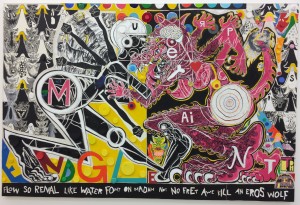
An unseen opponent batters James Kirkland with blows that literally make the flesh on his face shake in Paul Pfeiffer’s powerful video at Paula Cooper Gallery. By collaging together short clips that feature direct hits to the head and body and digitally removing Kirkland’s adversary, Pfeiffer focuses attention on the violence of boxing and turns fighter into victim. (In Chelsea through Nov 12th).
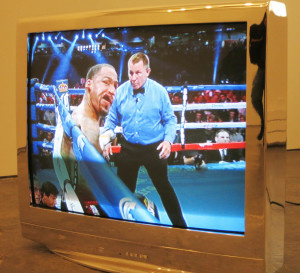
Cage-based artworks from the ‘60s to the early ‘80s by late, Paris-based Japanese artist Tetsumi Kudo at Andrea Rosen Gallery demonstrate human estrangement from nature. Despite the bright colors, a heart shape, plastic flowers and the label reading ‘Bonheur,’ happiness seems far from this abject couple’s experience. (In Chelsea through Nov 16th).
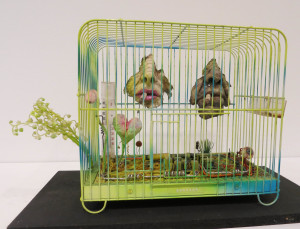
Created in mirror-polished stainless steel, this sculpture of a lifeguard by Scandinavian art duo Elmgreen and Dragset shimmers like an apparition on the Flag Art Foundation’s 9th floor terrace. Peering intently toward the Hudson River (or the buildings on the block in between), the guard is perpetually alert to a situation we can’t see. (In Chelsea through Dec 17th).
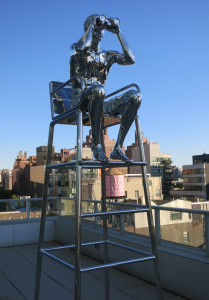
Hong Kong artist Chow Chun Fai paints stills from Hong Kong films, including this distillation of loneliness from Wong Kar-wai’s 1994 classic Chung King Express. Filmed just three years before Hong Kong’s return to China, the movie is about failed relationships and new beginnings, a position that interests Chow Chun Fai as Hong Kong heads towards socialist governance by 2047. (At Klein Sun Gallery in Chelsea through Nov 12th).
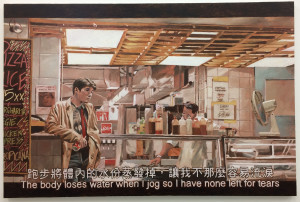
Spencer Finch literally changes the atmosphere inside James Cohan Gallery by creating an installation of hanging glass panels that create fog-like conditions inside the space. The shifting panels obscure the view across the gallery only from certain spots, meaning that visitors have to keep peering intently ahead to make out what’s there – an experience akin to moving through fog. (At Chelsea’s James Cohan Gallery through Nov 26th).
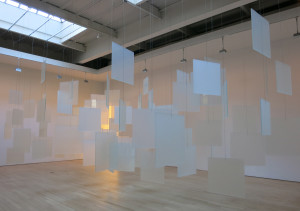
Inspired by sublime landscapes she’s encountered on road trips, Claire Sherman pictures the majestic outdoors as studies in light and form. (At DC Moore Gallery through Nov 5th).
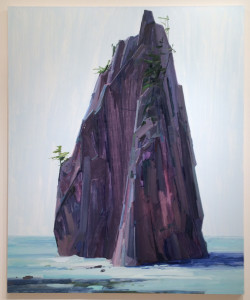
Against the backdrop of rapid urban development in the Persian Gulf countries, the artist collective GCC examines the parallel trends toward the pursuit of happiness and health. Here, a woman practices a new age, healing therapy on her son. They stand in sand, a symbol of the landscape, inside a racing track reminiscent of the region’s many new urban walkways. (At Chelsea’s Mitchell-Innes and Nash through Nov 23rd).
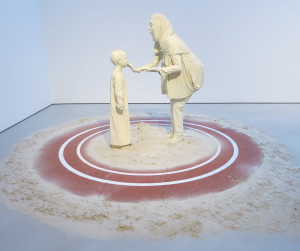
Glasgow painter Merlin James suggests a sweeping landscape with an extreme economy of means in this painting on nylon at Sikkema Jenkins & Co. A tree overlooking a placid shoreline dominates the foreground while lighter tones at center and a few intersecting diagonal lines to the left suggest distant, mountainous terrain. (In Chelsea through Nov 12th).
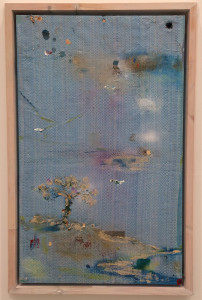
Incomplete female bodies are Brooklyn painter Caitlin Keogh’s signature subject matter, so it’s fitting that human hands are alluded to in this painting titled, ‘The Gentle Art of Making Friends.’ Intertwined with flowers reminiscent of medieval tapestries, this decorative pattern of weaponry has been (temporarily at least) converted into a trellis evoking a well-groomed garden more than an arsenal. (At Bortolami Gallery through Oct 29th).
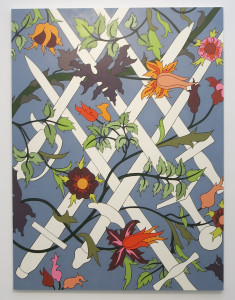
Jessica Segall’s light sculptures are off the grid in a uniquely local way at Cuchifritos Gallery, nestled in a corner of the Essex Street Market. Lemons and plantains speak of far-away climes but have been sourced from a nearby market stall and wired to produce power to (dimly) light this chandelier. (On the Lower East Side through Oct 30th).
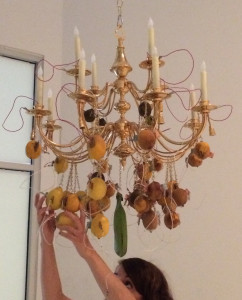
Working on the theory that you can make something so bad it’s good, Misaki Kawai presents faux naïve painting and sculpture at The Hole that entices with its wild color and cartoonish figures. (On the Lower East Side through Oct 30th).
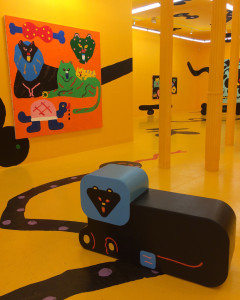
Jackie Gendel’s almost abstract chorus line of colorful figures appears chicly modern and homespun at the same time, recalling Gino Severini’s 1912 Futurist nightclub dancers but looking as if sewn together from fabric, an attractive and disarming effect achieved by painting in oil on vinyl. (At Thomas Erben Gallery through Oct 29th).
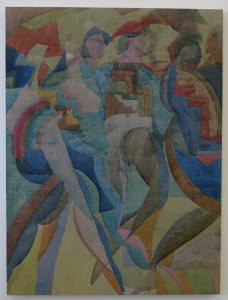
Two nudes descending a staircase by Georg Baselitz channels Marcel Duchamp’s famous 1912 Cubist figure but without the nervous energy. Upside down and painted in white, they are joined in the room’s other monumental paintings by ghostly characters who could be disappearing slowly downward into a dark pool of water, like Bill Viola’s transcending subjects. (At Gagosian Gallery’s 21st Street location in Chelsea through Oct 29th).
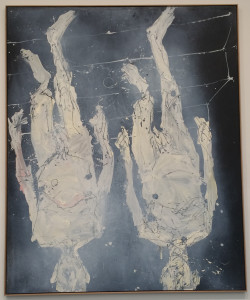
Does your furniture say something about your personality? Japanese design group Nendo goes a step further, suggesting that chairs themselves have personality, as demonstrated by fifty stainless steel seats. All were inspired by manga and intended to convey mood or attitude. Enhanced by swirling projections on the gallery walls, the chair in the foreground looks like it’s just arrived from another dimension, eager to please. (At Chelsea’s Friedman Benda through Oct 29th).
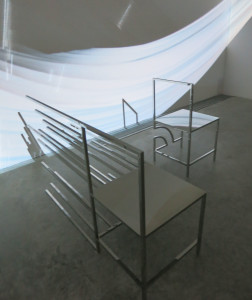
Walks and bus rides through Cleveland’s post-industrial landscape inspires Amy Casey’s amazingly intricate acrylic paintings. Here, the built environment mobilizes into twisted chains that evoke jewelry or a train set. (At Foley Gallery on the Lower East Side through Oct 30th).
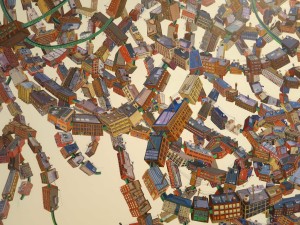
‘Not everything needs to be exalted and monetized,’ says Matthew Chambers, who allows gallery visitors to flip through his huge, painted books. On the gallery walls at Feuer Mesler, Chambers explores color via appealing flower paintings (left wall), tulip canvases are all about pattern, and torn canvas strips [right wall) morph into textured monochromes. (At Feuer Mesler Gallery on the Lower East Side through Oct 23rd).
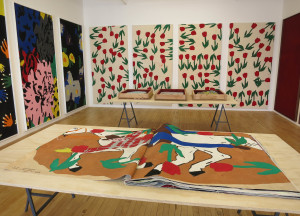
Jeff Elrod’s digitally inspired paintings may evoke a preschooler’s scrawl, but there’s something about ‘Rubber Miro’ that intrigues. Maybe it’s the necklace-like pattern or the pretty colors hovering somewhere in the background that make it hard to dismiss, maybe he’s succeeded in tapping into a subconscious, universal realm that Miro pioneered. (At Luhring Augustine Gallery through Oct 22nd).
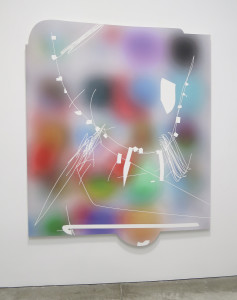
Born in the Northern Brazilian city of Belem, home to an annual religious festival that draws millions of participants, artist Tonico Lemmos Auad creates a series of attractively simple, handmade, crocheted forms inspired by votive vessels. (At CRG Gallery on the Lower East Side through Oct 23rd).
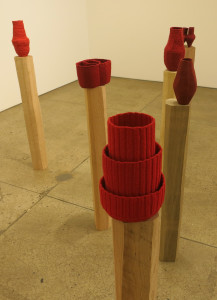
At a time when sensitive portraits of African Americans were far from the norm, 19th century Boston artist Francesca Alexander’s tiny ink on paper sketch from 1852 of Julia Benson charms. (At Driscoll Babcock Galleries in Chelsea through Oct 22nd).
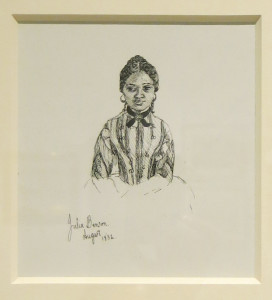
Female figures in long black dresses are the basis of this arresting canvas by Canadian painter Elizabeth McIntosh, who’s known for excerpting and riffing on elements of historical paintings. The identity of the repeated woman is a mystery, but the intensely yellow object coming from her hand – a notebook? handbag? a block of butter? – is the real puzzle that gives the painting intrigue. (At Canada on the Lower East Side through Oct 23rd).
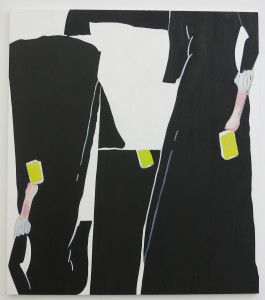
At over fourteen feet high, Lynda Benglis’ towering anthropomorph dominates her show of recent sculpture at Cheim & Read Gallery. Created by squirting spray foam onto chicken wire and casting the result in aluminum, its fragmentary quality makes it appear both imposing and fragile. (In Chelsea through Oct 22nd).
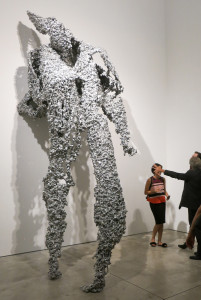
Lorna Simpson’s understated, monochrome images employ collaged fragments from magazines like Ebony and Jet in a powerful, poetic mediation on race in America. (At Salon94 Bowery on the Lower East Side through Oct 22nd).
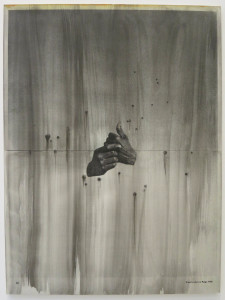
Sally Gall’s gorgeous, boldly colored photos bring to mind flowers, sea creatures and fungi; in fact, the billowing organic shapes are laundry items, photographed from under a drying line. The show wonderfully affirms the beauty in the everyday. (At Julie Saul Gallery through Oct 22nd)
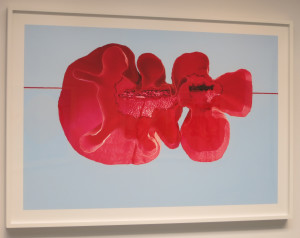
From obsolete reference books, New York artist Brian Dettmer creates found poetry, collages and sculpture that literally manipulate knowledge into fascinating new forms. (At Chelsea’s PPOW Gallery through Oct 15th).
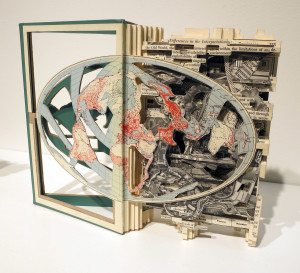
Meleko Mokgosi’s provocative pairing of three regal African women with a massive bull implies that we’re looking at two powerful forces. The diptych’s subtitle is ‘Lerato: Philia I’ the Setwana word for love (used as a noun in reference to a woman) followed by a suffix that brings to mind excessive devotion. (At Jack Shainman Gallery on 20th and 24th Streets through Oct 22nd).
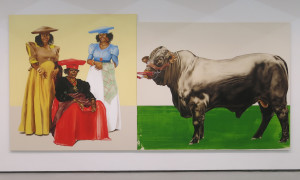
Kyle Staver’s large paintings at Kent Fine Art update legends and classical mythology with panache and humor, but her small terracotta studies stand out for their immediacy. Here, Venus tries unsuccessfully to persuade Adonis not to venture out on his ill-fated hunt in a compressed action scene that casts Venus as a solid earth-mother and Adonis as an ungainly and heedless youth. (In Chelsea through Oct 22nd).
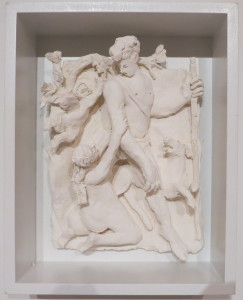
In a grouping of hand-painted wooden torpedoes, Marianne Vitale swaps out her signature bold, minimalist sculptures made with railway ties or battered wood for personalized weapons bearing ‘American’ symbols including USDA meat and Pollock-like swirls of paint. (At Invisible-Exports on the Lower East Side through Oct 16th).
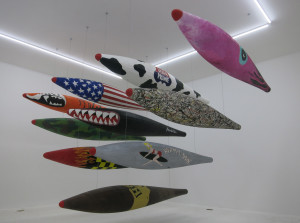
In Jeffrey Beebe’s richly imagined worlds, he pits ‘the Uncles’ – leaders of the Rover clans – against the ‘Red Soil Boys’ – a bellicose neighboring group who initiated an attack that wiped out many Uncles. In this detail from a grid of lost Uncles, Beebe introduces one of his fantastical creatures – a 21 ft long giant whose horn ‘improved both echolocation and moral indignation.’ (At Bravin Lee Programs in Chelsea through Oct 15th).
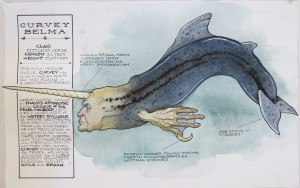
Sol LeWitt’s Wall Drawing #368 appears to pulse and move as it surrounds visitors to Paula Cooper Gallery. In addition to the physical impact, there’s also appeal in imagining the various ways LeWitt’s instructions (as enumerated in the drawing’s title) could be interpreted. (In Chelsea through Oct 22nd).
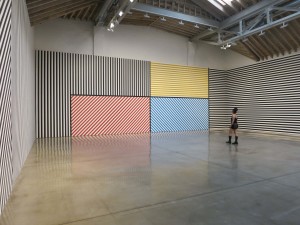
In 1968, Bruce Nauman videoed himself slowly pacing down a narrow corridor, swinging his hips with each step into a pose reminiscent of Donatello’s bronze David sculpture. Once again, Nauman posits the human body – now older and fragmented by a screen with multiple splits – as subject for art in a new series of videos at Sperone Westwater Gallery, also on view at the Philadelphia Museum of Art. (On the Lower East Side through Oct 29th).
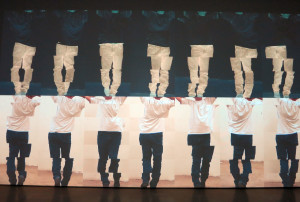
Ruth Root’s untitled abstraction, created on fabric and Plexiglas dominates Jack Hanley Gallery’s group exhibition ‘The Congregation.’ With its unlikely form, as suggestive of a living creature as an eccentric chair, and mix of wonky hand-created forms and slick pattern, it’s hard to settle on one set of meanings for this wonderfully shape-shifting piece. (On the Lower East Side through Oct 9th).
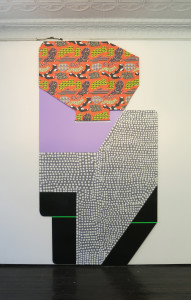
Black canvases, some formerly used as studio rags, hang from wires in David Zwirner Gallery’s Chelsea space in Oscar Murillo’s new installation, dividing the gallery into sections like a make-shift field hospital. Even more ominous are sculptures inspired by morgue tables and a huge torn canvas featuring a bank note. Both are a far cry from the artist’s last show – for which he created a chocolate factory in the gallery. (Through Oct 22nd).
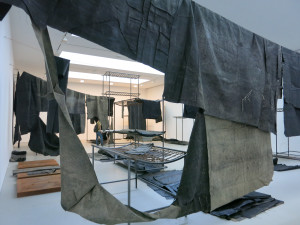
LA sculptor Peter Shire’s ‘Scorpion’ strikes a fencing pose, but something about the red ball on top of this exaggerated tea-pot shape tones down the menace. Behind it, other sculptures reveal Shire’s involvement with the Memphis design group in the 80s and his own sense of humor in a deeply enjoyable survey of the artist’s work from the 70s to the present. (At Derek Eller Gallery on the Lower East Side through Oct 9th).
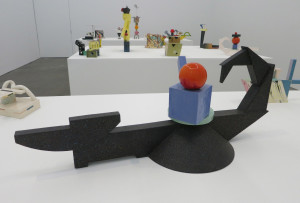
Twice a day for ten minutes, gallery staff at Lehmann Maupin Gallery switch on this magical instrument, constructed by Brazilian street art twins OSGEMEOS. The gallery fills with an eerie melody in keeping with the dream-like setting constructed by the duo, transporting visitors far away from the everyday. (In Chelsea through Oct 22nd).
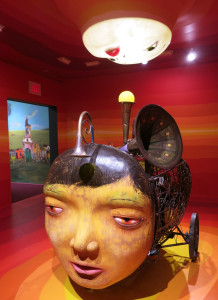
Titled ‘Curves,’ Bayne Peterson’s solo show of wood and metal sculpture at Kristen Lorello channels sensuous forms of the mid-20th century modernists (Barbara Hepworth, Henry Moore) in dizzying color. At front left, ‘Apollo’ shares a name with the Roman god of music, appropriately, as the sculpture recalls a giant ear resting on a receiver. (On the Lower East Side through Oct 16th).
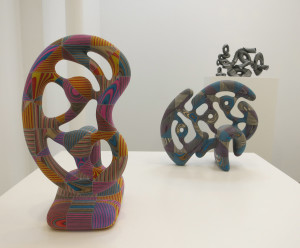
In Ugo Rondinone’s exhibition of stacked sculptures at Barbara Gladstone Gallery in 2013, the Swiss artist piled rocks to resemble human figures. Here, vivid colors set the tone for a show that is about visual pleasure. In the background, a circular form (made from branches cast in aluminum and gilded) stands in for the sun setting over this cheery, primordial landscape. (In Chelsea through Oct 29th).
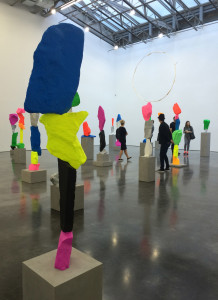
Chicago artist and member of the iconic Hairy Who artist group, Suellen Rocca devises a language of her own in this symbol-laden, nearly 10-foot long canvas from 1965 at Matthew Marks Gallery in Chelsea. Dominated by the perfect beauties of advertising, simplified down to their silhouettes and made sinister with modified features, Rocca’s painting ponders the temptations of consumer culture. (Through Oct 22nd).
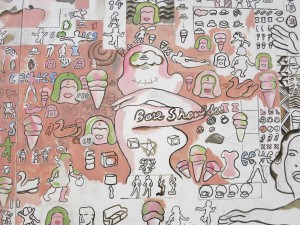
British artist Cornelia Parker merges the all-American image of the red barn with the equally iconic exterior of Norman Bates’ house from Hitchcock’s Psycho in her delightfully eerie Roof Garden commission at the Met. Constructed from an old barn and consisting of only two facades, the home invites comparison to the largely vacant 432 Park Ave that dominates the skyline in the background. (At the Metropolitan Museum of Art through Oct 31st).
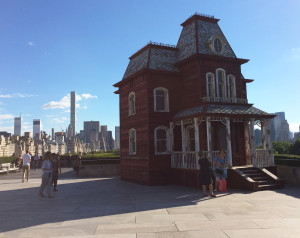
Alix Pearlstein is known for artworks which juxtapose individuals from different demographics in order to question their relationships; for her recent solo show at On Stellar Rays, she substitutes cats for people, setting up dozens of relationships between the animals which are complicated by the installation’s title, Harem ROOM 1. (On the Lower East Side through Oct 18th).
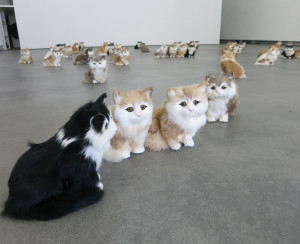
Brie Ruais’ wall mounted sculpture is designed to record the trace of her hands forming the shape of the sculpture, Sally Saul’s little women offer a kind of canvas for her ceramic compositions and Sara Murphy’s leg sawhorses provide a support for unnamed table-top activities. All expound on the human body as inspiration for creativity. (At Rachel Uffner Gallery on the Lower East Side through Oct 23rd).
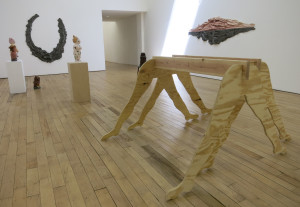
Taking the doubts of Christ’s disciple Thomas as subject matter, Beijing-based artist Miao Xiaochun attempts a radical transformation of his own, departing from traditional art-making techniques to explore how hand drawing on canvas from 3D models might energize his paintings. (At Klein Sun Gallery through Oct 8th).
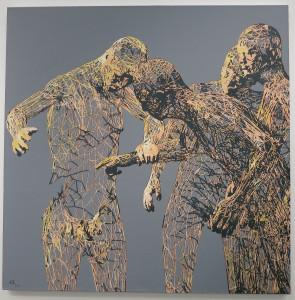
Awash in light, Hung Liu’s painting of an American sharecropper from near Jackson Mississippi belies the difficulty of this Depression era woman’s life as originally pictured in a photo by Dorothea Lange. Liu lifts her subject from the realm of documentary and considers her – via the same image – from an alternative angle. (At Nancy Hoffman Gallery through Oct 22nd).
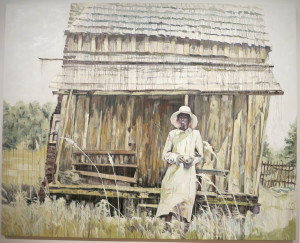
Number 181 is a powerful presence at the entrance to abstract sculptor Leonardo Drew’s latest solo show at Chelsea gallery Sikkema Jenkins & Co. Thick clusters of driftwood project out over viewers who draw close to explore small sticks with white ends laid out in lines between rows of variously shaped pieces of wood. In this and the show’s other sculptures, Drew powerfully juxtaposes chaotic arrangements and careful order. (Through Oct 8th).
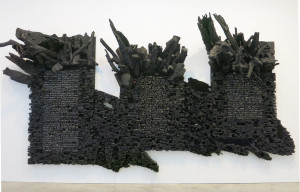
Digital technology allows us to be (at least in our conscious minds) in more than one place at a time. Abstract painter Sarah Walker engages the possibility of seeing multiple dimensions at once in her ‘space machine’ paintings, canvases that seem to offer portals into parallel universes. (At Pierogi on the Lower East Side through Oct 9th).
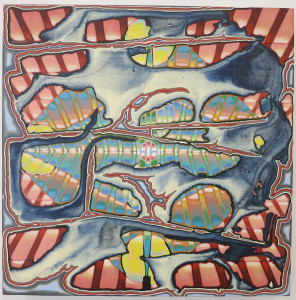
The colors of Gustav Klimt’s famous portrait of Viennese girl Mada Primavesi (in the Met’s collection) inspired this lush painting by British artist Ian Davenport, seen here in detail. In Klimt’s original, Mada’s slim figure barely stands out against a background of white, lilac and pink color; here, Davenport allows the colors to take over fully. (At Paul Kasmin Gallery through Oct 22nd).
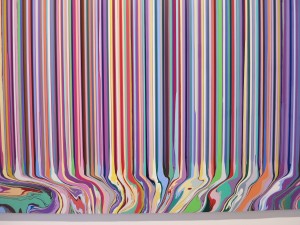
Hands down, the best views from any piece of New York real estate are to be had from a tiny, isolated shack on the side of a hill overlooking New York Bay. You can’t actually enter Rachel Whiteread’s ‘Cabin,’ for which she cast a small structure in concrete, but the surroundings are more the point anyway. With Manhattan’s skyscrapers in view to the north and the Statue of Liberty looking over from the east, this new permanent public artwork is both isolated and at the center of the city. (On permanent view on Governors Island).
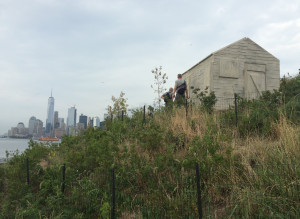
Judith Schaechter’s relatively small stained glass work, ‘Botanical Study,’ opens a show of new work that pits the human body against fabulous depictions of nature in all its rich abundance. Here, Schaechter ignores humans entirely, zeroing in on a single drop of rich plant and insect life, amplifying the wonders of the natural world. (In Chelsea at Claire Oliver Gallery, through Oct 22nd).
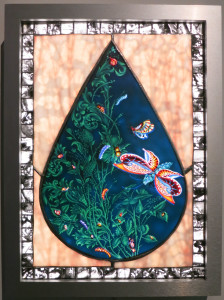
LA artist Wayne White combines set design with his signature word paintings to eye-popping effect in his latest Chelsea solo exhibition at Joshua Liner Gallery. Using found prints or paintings as backgrounds, he adds phrases that are completely at odds with their tranquil subject matter and more in keeping with iconic movie lines; here, the phrase, ‘I’m gonna play like you didn say that’ dominates a mountainscape. (Through Oct 8th).
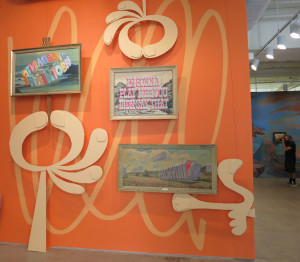
While living in an artfully converted shipping container next to a Costco parking lot in Queens, New York sculptor Lars Fisk developed his hugely entertaining concept of a real-world place rolled up into a tidy, circular package. His first show at Chelsea’s Marlborough Gallery features the largest ‘Lot Ball’ to date, along with balls inspired by subway signs and a Mr Softee truck. (Through Oct 15th).
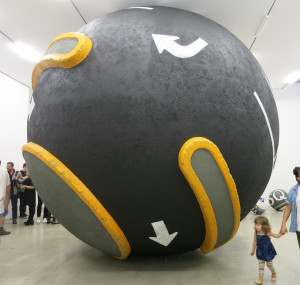
At the center of Rashid Johnson’s ‘architectural grid work,’ classically trained pianist Antoine Baldwin plays jazz compositions on a piano fixed high in the structure. Complex and intriguing sounds merge with an arrangement of evocative objects – plants in planters hand-made by the artist, blocks of shea butter, stacks of books relating to African-American culture and early video work by Johnson. Together they continue the artist’s theme of freedom and anxiety experienced by African-American men in America, offering escape through lush greenery (signaling travel to a warmer land) and abundant reading material (liberation for the mind) or imprisonment by a rigid grid. (At Hauser & Wirth Gallery through Oct 22nd).
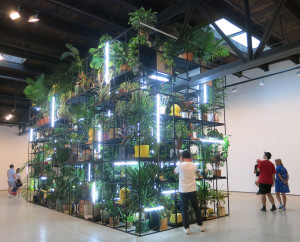
In David Opdyke’s nimble hands, subtly altered vintage postcards meant to stoke civic pride instead provoke dismay in a new series on view at Chelsea’s Magnan Metz Gallery. Opdyke prophesies doom in drawings, textiles and animations themed on class warfare and a dysfunctional government. Here, an august Chicago High School experiences a surreal trauma inflicted by a giant pencil (Through Oct 22nd).
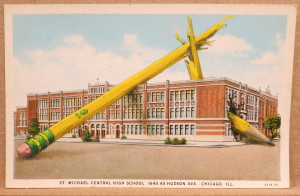
Jonas Woods’ monumental painting of late basketball player Dwayne Schintzius offers a tragic figure for contemplation. After a promising start in college basketball, health problems thwarted Schintzius’ career before he died due to complications of leukemia in his early 40s. At over seven feet tall, with a mullet hairstyle as renowned as his sports skills, Schintzius was a particular type of American hero; Woods prompts us to ask what kind with his over nine-feet-tall canvas. (At Chelsea’s Anton Kern Gallery through Oct 22nd).
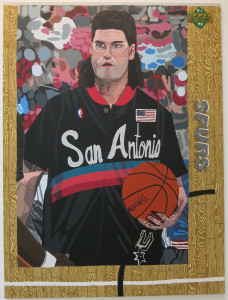
Art audiences love experiential art (witness long lines at every Yayoi Kusama walk-in sculpture, the Rain Room, etc), so it’s somewhat surprising how few painters offer to envelop viewers in their work. Sarah Cain is not one of the reticent artists, however. Her installation, Dark Matter, at Chelsea’s Galerie Lelong covers the gallery floor in bold patterns on lino, competing with but also complimenting vibrant canvases that employ beads, pinwheels, string and more to take the composition off the canvas. (Through Oct 15th).
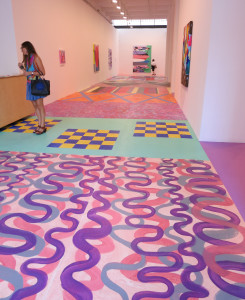
Lynn Katsafouros updates the Byzantine icon with this painting of a saintly woman with a resigned stoic look, surrounded by tiny birds and wearing what could be an artist’s smock. (At Prince Street Gallery through Oct 1st).
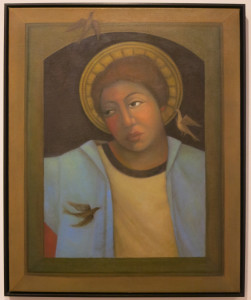
Excessive squeezes of oil paint – created using pastry bags – on Xu Zhen’s canvases reach toward the viewer like living creatures, invoking coral or clusters of candy-colored undersea invertebrates. Produced by the artist’s ‘MadeIn Company’ and titled ‘Made in Heaven,’ the work nods to factory-like art production (referencing Jeff Koons’ ‘Made in Heaven’ photo series, for example) while offering a lush abstraction that looks good enough to eat. (At James Cohan Gallery through Oct 8th).
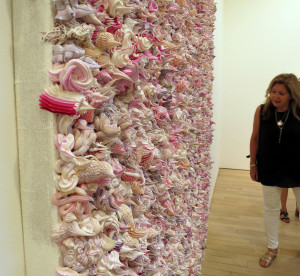
Gillian Wearing’s now classic video of herself dancing uninhibitedly in a London shopping arcade in 1994 – causing discomfort with the idea of turning public into private space – is precedent setting in the International Center of Photography’s group show ‘Public, Private, Secret,’ which considers how identity is created both openly and in secret. (Through Jan 8, 2017).
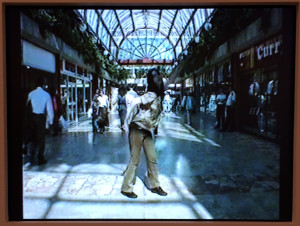
Ydessa Hendeles’ ‘Partners (The Teddy Bear Project)’ is a standout in ‘The Keeper,’ the New Museum’s intriguing homage to obsessive collections of deeply meaningful, often personal, artifacts. The installation presents over three thousand photographs from diverse family albums of individuals with their teddy bears, taken since the stuffed animal came into existence thanks to Teddy Roosevelt’s hunting exploits. Here, teddies break through class barriers, age differences and cultural divides as the world embraces a mass-produced consumer good. (Through Sept 25th).
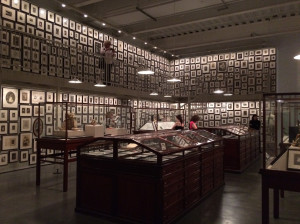
Martin Puryear’s huge wooden structure, sheathed in chain-link fencing and capped with a gold-leafed shackle, towers over Madison Square Park’s main lawn like a seated animal. Its shape echoes the Phrygian cap, associated with French revolutionaries and freedom and explored recently by the artist, and is topped off with a gorgeously gleaming shackle – a gilded symbol of servitude. (At Madison Square Park through January 8th, 2017).
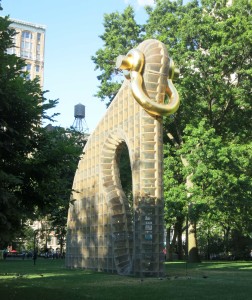
Sleeping bags filled with rubble from nearby construction sites make for an eerie sculpture by British artist Mike Nelson. Placed in semi-hidden locations on the High Line, the bags contrast the luxurious living conditions being created in the neighborhood’s new buildings with solitary, make-do survival. (In ‘Wanderlust’ on the High Line through March 2017).
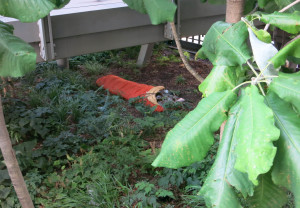
Smart cars snag great parking spaces in New York; this one, created by Harlem-based artist Nari Ward, enjoys a privileged place on the High Line where an admiring audience regularly surrounds it. Inspired by an abandoned car that hosted a lime tree in his father’s yard in Jamaica, Ward planted an apple tree in this car, lining the exterior with rubber tire treads and turning a symbol of nimble urban driving into a stationary support for nature. (On the High Line through March 2017).
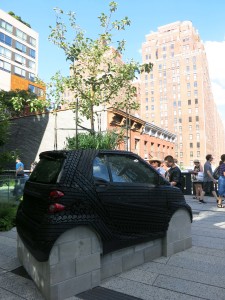
Matt Johnson’s ‘Untitled (Swan)’ marries industrial materials to the natural world by shaping a train track into the shape of an abstract swan set in the High Line’s lush gardens. Known for morphing everyday items – a crumpled Starbucks cup carved from wood and painted, a stack of plastic party cups actually rendered in painted bronze – into objects of wonder, this twisted rail pays homage to the former rail line on which it’s installed. (In ‘Wanderlust’ on the High Line through March 2017).
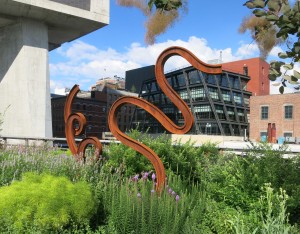
Tony Matelli pioneered his hyper-realistic sculptures before the social media era, yet they seem made for photographing and sharing. This bronze sleepwalker is a major traffic-stopper on the High Line not just as an art object in its own right but as a catalyst for audience interaction. (In ‘Wanderlust’ on the High Line through March 2017).
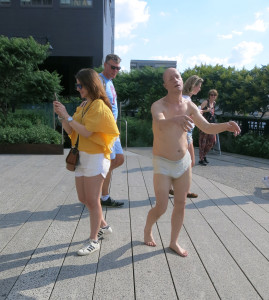
Known for hyper-detailed renderings of the male body (among other natural subjects), Ellen Altfest’s ‘Leg’ ponders the facts on a section of a man’s leg. Veins, hair, and tiny blemishes are the ostensible subjects of the painting, but the limb gives off a vital glow, contrasting its grey surroundings and suggesting that even a fractional view of her subject bears close scrutiny. (At Cheim & Read Gallery in ‘The Female Gaze, Part Two: Women Look at Men’ through Sept 2nd).
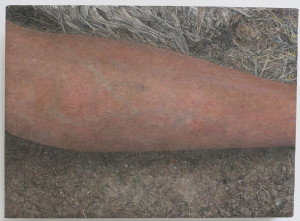
Alex Katz’s towering painting of his wife, Ada, in red coat, hat and lips dominates a selection of paintings by the artist at the Metropolitan Museum of Art. As bold as an advertisement but with no product to sell, this arresting painting celebrates Ada’s allure. (Through Nov 6th).
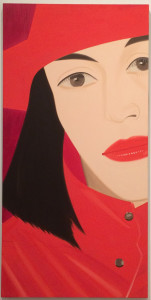
Hungarian avant-garde artist Laszlo Moholy-Nagy used camera-less photography to create experimental pictures like this one, for which he put his own face and glasses against light-sensitive paper in the darkroom and made multiple exposures to create this ghostly image. (At the Guggenheim in ‘Moholy-Nagy: Future Present’ through Sept 7th).
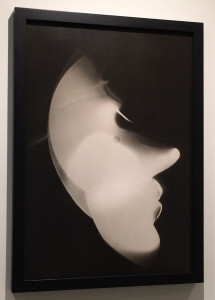
Sweden-based artist Nathalia Edenmont is both collector and artist – using rare butterfly wings she acquires at fairs in Singapore and Paris, she creates labor-intensive collages that uniquely comment on nature’s beauty. (At Chelsea’s Nancy Hoffman Gallery through Sept 1st.)
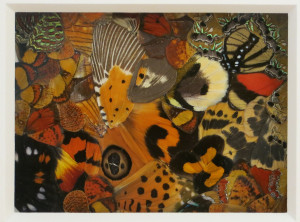
We are like characters in a disaster movie, writes photographer Hiroshi Watanabe – though terrible events loom, we carry on with life as usual. Here, snow-covered persimmons make for a beautiful image but one that warns of a fast-arriving, harsher season. (At Chelsea’s Benrubi Gallery through Aug 26th).
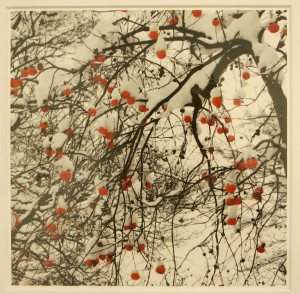
Wild abandon meets danger in this 1974 photo by counterculture photographer Roger Steffens, though what appears to be a fatal leap is an illusion – the young woman landed safely on the ledge directly beneath her. Under the titled ‘The Family Acid,’ Steffens’ photos chronicle the lives of his friends and family as they embody the changing mores of an era. (At Benrubi Gallery in Chelsea through Aug 26th).
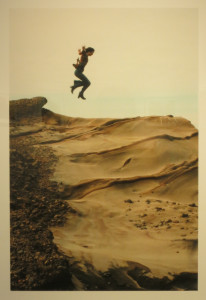
Neatly tiled platforms suggest a clean and ordered place while glasses with red sticks hint at incense offerings in New York artist Libby Rothfeld’s evocative ‘Option #1,’ currently at Canada New York on the Lower East Side. The setup entices us to make up our own story – one in which a fragile crown sporting a fairy-like face might find its way to an Asian supermarket shopping basket filled with potatoes… (Through August 26th).
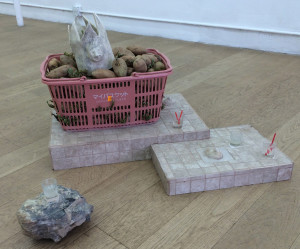
Located in the same room as the Queens Museum’s model of New York City’s water system, Duke Riley’s ‘That’s What She Said’ is a commissioned work warning against misuse of a precious natural resource. To the left, an Egyptian goddess creates the waters that flow down into a landscape destroyed by power plants and the indifference of its inhabitants. (Through Jan 1, 2017).
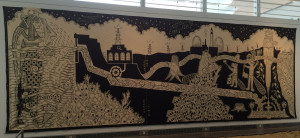
Sopheap Pich’s bamboo and rattan flower is made of natural materials but resembles computer-generated imagery. In fact, this flower – from the cannonball tree – has personal meaning to the artist. It represents the tree that sheltered Buddha during his birth and is found near Buddhist temples and Pich’s home. (At Tyler Rollins Fine Art in Chelsea through Aug 26th).
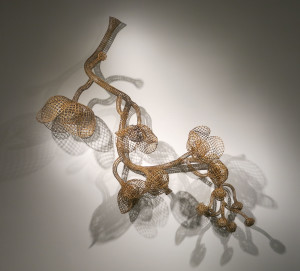
Influential for his photographs of consumer culture items isolated and made strange, as well as his laborious tri-color Carbo printing technique, Paul Outerbridge is currently celebrated at Bruce Silverstein with a retrospective including this intensely colored cinematic homage to spring. (At Bruce Silverstein Gallery in Chelsea through Sept 17th).
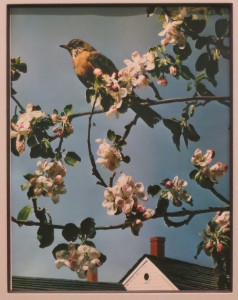
Painting over You Tube video stills, Iranian artist Rokni Haerizadeh morphs familiar imagery into a setting for mythological creatures inspired by Persian tradition. Here, a building echoes the Guggenheim’s spiraling form but is surrounded by emergency vehicles, one of which has partially changed into a fish. (At the Guggenheim, in ‘A Storm is Blowing from Paradise: Contemporary Art of the Middle East and North Africa’ through Oct 5th).
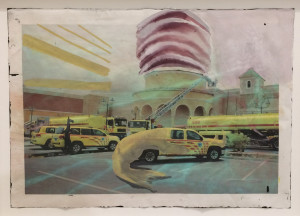
To make work for the 2012 Echigo-Tsumari Art Triennial, photographers RongRong and inri packed up their family and moved from Beijing to rural Japan, creating timeless, ethereal black and white scenes shot in a 200-year-old house. (At Chambers Fine Art in Chelsea through Aug 20th).
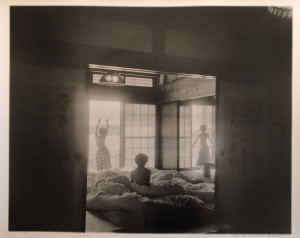
British artist/designer Richard Woods has applied mock Tudor façade to a shopping mall in Seoul, fake flagstones to a cottage in Finland, and now brings a collection of woodblock tabletops to Friedman Benda Project Space in Chelsea. Presented as both tables and wall-mounted works, the exhibition’s vibrant color and patterns celebrate the places where we eat, work and commune. (Through Aug 19th).
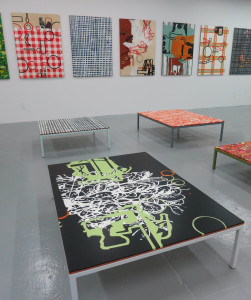
From a 1962 painted black rectangle by Sol LeWitt to a series of canvases hung from the ceiling by Oscar Murillo, Pace Gallery’s ‘Blackness in Abstraction’ discusses varieties of blackness, touching on race, the life of the spirit and simplicity of form. (On 25th Street in Chelsea through Aug 19th).
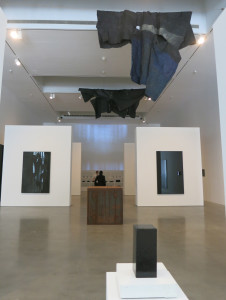
German artist Peter Pillar spotted this surprising image of a woman being silenced by a ghostly hand while driving as he himself was traveling on the highway. As part of a series for which he photographed ads on the back of trucks, then removed text and non-image related info, Pillar lays bare how the images send particular messages. It’s an enticing challenge to imagine what’s would be sold by the original ad. (At Andrew Kreps Gallery through Aug 19th).
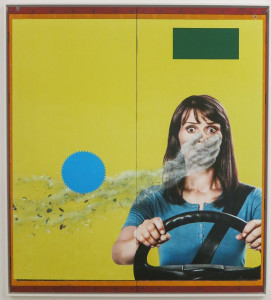
Using found objects, Fred Wilson tells a story of a man – in the form of a classic Greek bust – who lies broken before a stoic young African woman in the artist’s 2005 ‘Love and Loss in the Milky Way.’ Surrounded by glowing white milk glass objects (plates and various vessels) with two motherly figures positioned behind them, their disastrous encounter becomes a racially charged rendition of Romeo and Juliet. (At Pace Gallery on 24th Street in Chelsea through Aug 19th).
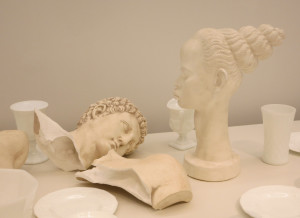
Chicago-based octogenarian Margot Bergman makes her New York solo debut with highly emotive, expressionist portraits created on canvases found in thrift stores and flea markets and reworked into double portraits. Here, a kindly, elderly face peers out from the forehead of a pouty-lipped blond, perhaps foretelling the younger woman’s future or portraying her internal voice. (At Chelsea’s Anton Kern Gallery through Aug 19th).
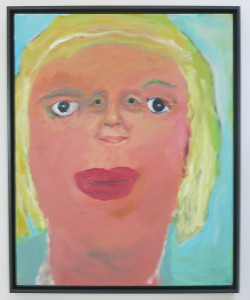
Nancy Shaver marshaled work by twenty-four artists to create ‘Quilt,’ a wall collage of Shaver’s own fabric panels and works in other media which spreads out over Derek Eller Gallery’s walls like a kudzu of patterns and pop culture references. (On the Lower East Side through Aug 19th).
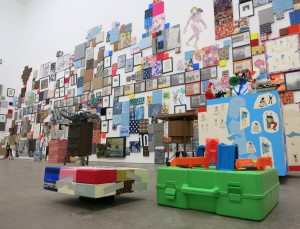
Young Saskatchewan-based artist Zachari Logan asserts a new place in the natural world for the male body in works like ‘Leshy,’ a human figure created from flora and fauna, beautifully rendered in pastels on black paper. (At Julie Saul Gallery in Chelsea through Aug 12th).
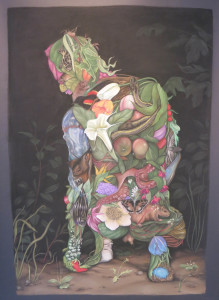
Realist painter Don Nice pairs soda pop and pop corn in a Warholian consideration of the allure of brightly packaged processed food. These two paintings hang side by side in Nice’s current show at Driscoll Babcock Galleries, as if arranged for our viewing and eating pleasure. (In Chelsea through Aug 12th).
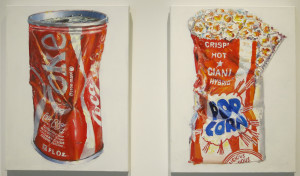
Karen Lederer’s ‘Hipster Wellness’ is a standout in Driscoll Babcock’s summer group show of painting by young artists who follow new approaches to traditional still life. Bright colors dominate, particularly a glowing bowl of Cheetos, which balances the orange color squares on an art book about Josef Albers. Painted as if seen in digital space, the picture includes Lederer’s own hand, not wielding a brush but as if poised to take a selfie. (In Chelsea through Aug 12th).
